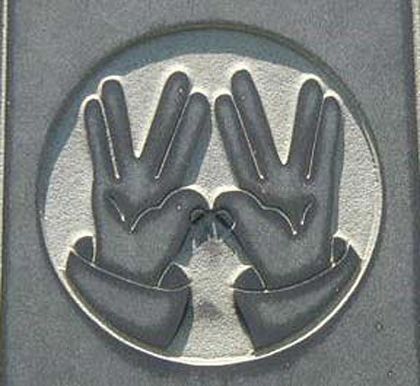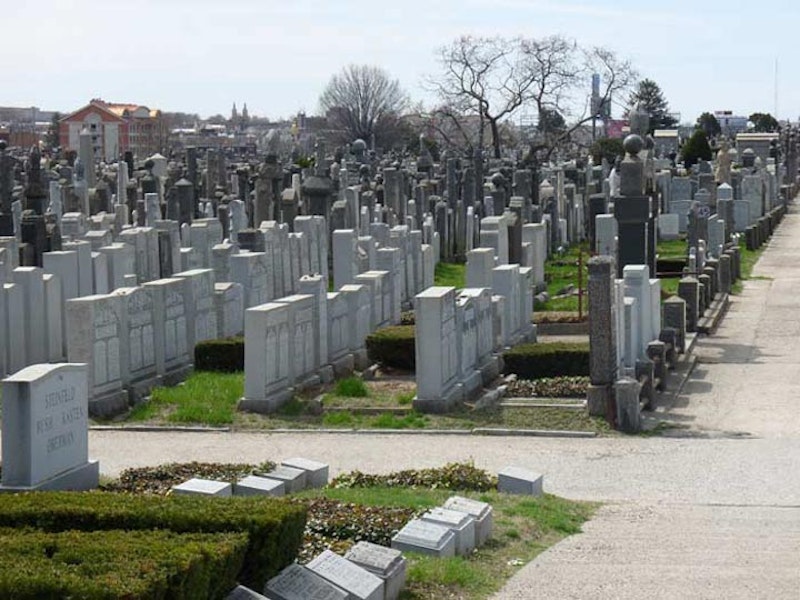In the 1850s, New York City decided it didn’t want its dead anymore. Rising real estate costs and an ever-expanding urban frontier led NYC to pass a law prohibiting any more burials in Manhattan in 1852. Churches and synagogues, which had begun to make a profit running cemeteries, looked east to Queens County, then a vast forest containing farms and the occasional small town like Flushing and Jamaica. St. Patrick’s Cathedral opened Calvary Cemetery in 1848, 40 years before its big 5th Ave. cathedral opened.

Mount Zion, a Jewish cemetery, occupies about 80 acres in Maspeth near New Calvary Cemetery and the BQE. It was opened in the early-1890s under the auspices of Chevra Bani Sholom and later by the Elmwier Cemetery Association (Elmwier Ave. is a former name of 54th Ave.).
A walk in Mount Zion will produce a surprising and poignant reminder of burial practices long forgotten… the faces of the dead are preserved on some of the tombstones. In a process known as “enameling,” photographs of the deceased are burned into porcelain (in a process described in detail in John Yang’s book Mount Zion: Sepulchral Photographs.) This was a custom brought to the U.S. by Jewish immigrants from Eastern Europe.
A look at newer gravesites in New York City reveals that placing photos of the deceased on gravestones is returning. In the Mt. Zion stones, the tablets are mostly oval and some are gilt-edged. Some are heavily retouched, so they look vaguely unreal, as if they were drawn, not shot with a camera. Some are formally posed while others are candid. Many capture people in their prime; so many died young in that era. Most of the men are attired in suits, while the women sport the big hats popular around the turn of the last century.
Mt. Zion is open six days a week (except Saturdays), and while Yang’s book is hard to find on area bookstore shelves, it’s available at Mt. Zion’s office, which is modern and has a friendly staff.

Mt. Zion Cemetery is also where many of the victims of the Triangle Shirtwaist Factory fire of 1911 are buried. On Saturday, March 25 of that year, as quitting time approached, a fire broke out on the eighth floor of the Asch Building near Washington Square, and spread rapidly on the top three floors of the building. In a scene reminiscent of the General Slocum tragedy seven years earlier, fire hoses were woefully inadequate to battle the flames, the lone fire escape was rickety and rusted, and the doors to the exits were locked to ensure that the mostly immigrant women working the sewing tables wouldn’t wander or steal anything.

There was little escape from the flames and in a scenario that foreshadowed the 9/11 terrorist attack, the women were forced to jump out of windows or burn to death, and many chose the former. While some were able to escape by an open staircase and an elevator, 145 employees would perish. In less than a half hour, the fire was brought under control. Triangle owners Isaac Harris and Max Blanck were charged with manslaughter; after a two-week trial they were found innocent.

Three years after the fire, on March 11, 1914, 23 civil suits against the owner of the Asch Building were settled. The average recovery was $75 per life lost.

Leonard Nimoy often said that he got the Vulcan “live long and prosper” hand signal at temple. It’s the Aaronic blessing given at services and is done with both hands, thumb to thumb, and represents the Hebrew letter shin. I’ve often tried, unsuccessfully, to make my fingers do this; I’m told it’s hereditary: like touching your nose with your tongue or wiggling your ears, either you can do it or you can’t. Mt. Zion Cemetery’s Triangle Shirtwaist Fire memorial can be accessed by entering the cemetery via the Tyler Avenue gate between 63rd and 64th Sts. in southern Woodside. It’s a short distance up the path on the left as you enter.
—Kevin Walsh is the webmaster of Forgotten NY and the author of Forgotten New York and, with the Greater Astoria Historical Society, Forgotten Queens. Forgotten New York the website was the first recipient of Outstanding New York Website, awarded by the Guides Association of New York City in 2015

